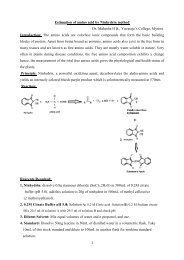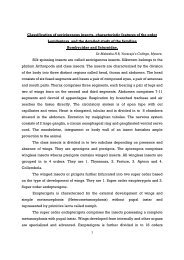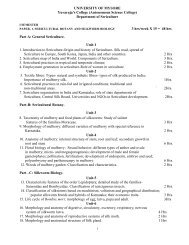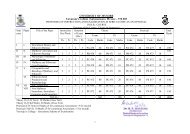SILKWORM PATHOLOGY - Dr. HB MAHESHA
SILKWORM PATHOLOGY - Dr. HB MAHESHA
SILKWORM PATHOLOGY - Dr. HB MAHESHA
Create successful ePaper yourself
Turn your PDF publications into a flip-book with our unique Google optimized e-Paper software.
<strong>SILKWORM</strong> <strong>SILKWORM</strong> <strong>SILKWORM</strong> <strong>SILKWORM</strong> <strong>SILKWORM</strong> <strong>PATHOLOGY</strong><br />
<strong>PATHOLOGY</strong><br />
<strong>Dr</strong>. Mahesha H B<br />
Associate Professor and Head<br />
Department of Sericulture<br />
Yuvaraja’s College,<br />
University of Mysore, Mysore, India<br />
4 December 2012 1
Pathology-The scientific study of the nature of<br />
disease and its causes, processes, development,<br />
and consequences. Also called pathobiology.<br />
Fungal<br />
Bacterial<br />
Viral<br />
Protozoan<br />
4 December 2012 2
Viral<br />
Viral diseases of silkworm comprise of inclusion<br />
and non-inclusion types.<br />
The inclusion virus diseases form typical inclusion<br />
bodies. They are Nuclear polyhedrosis and<br />
Cytoplasmic polyhedrosis.<br />
The non-inclusion type consists of Infectious<br />
flacheric and Densonuclcosis.<br />
4 December 2012 3
Nuclear Polyhedrosis<br />
It is one of the most serious virus diseases in<br />
tropical countries and occurs throughout the year.<br />
This disease is otherwise known as Grasseric,<br />
Jaundice, Milky disease, Fatty degeneration and<br />
Hanging disease.<br />
4 December 2012 4
Causes of the disease<br />
This disease is caused by Borrelina bombycis virus<br />
belonging to the sub-group A of the family<br />
Baculoviridae. The shape is usually octadecahedral or<br />
hexahedral and sometimes tetragon or trigon.<br />
Infection mostly takes place through feeding, rarely<br />
wounds.<br />
4 December 2012 5
Symptoms:<br />
During early part of the disease no<br />
symptoms are noticed except the<br />
worms being slightly sluggish.<br />
Initially the skin shows oily and shining<br />
appearance.<br />
As the disease advances the skin<br />
becomes thin and fragile and the body<br />
becomes milky white with<br />
intersegmental swellings.<br />
contamination.<br />
Another characteristic symptom or this<br />
disease is that the larvae become<br />
restless and crawl aimlessly along the<br />
ridges or rims of rearing trays.<br />
4 December 2012 6
Death - 4-5 days in the young larvae<br />
5-7 days in the grown-up larvae.<br />
Diseased larvae lose the clasping power<br />
of abdominal legs except the caudal<br />
legs by which it hangs with<br />
the head downwards.<br />
Melted Cocoons<br />
4 December 2012 7
Prevention and control:<br />
Maintenance of hyegenic condition by disinfection<br />
Optimun Environmental Conditions<br />
Quality Leaf<br />
4 December 2012 8
In addition, certain bed disinfectants prevent secondary<br />
contamination and spread of the disease.<br />
Paraforrnaldehyde compounds like Reshamkeet<br />
Oushadh<br />
Dusted on the larvae and bed with the help of a thin<br />
cloth at the rate of 2-3 grams/0. 1 sqm. area during early<br />
instars and 4- 5 grams/0.1sqm. during IV and V instars.<br />
Fro 100 dfls (40,000 larvae) is 3-3.5 kgs.<br />
4 December 2012 9
PROTOZOAN DISEASES -Pebrine<br />
Protozoa<br />
- class Microsporidia<br />
- genera Nosema, Pleistophora & Thelohania.<br />
The major protozoan disease of the silkworm is the<br />
pebrine disease, named due to the appearance of<br />
black peppery patches following infection.<br />
4 December 2012 10
Pebrine<br />
Pebrine is a chronic and disastrous disease<br />
responsible for the sudden collapse of the<br />
silkworm industry of both France and Italy in 1965<br />
The techniques of strict mother moth<br />
examination for the supply of disease free<br />
silkworm eggs.<br />
4 December 2012 11
Causes of the disease: by Nosema bombycis Nageli<br />
Infection by both peros and transovarial<br />
Primary and Secondary infection<br />
4 December 2012 12
The mature spore is oval or<br />
ovocylindrical with 3 -4x 1.5 -2.5 µ<br />
& three layered membrane: the<br />
inner, middle and outer.<br />
The sporoplasm contains a pair of<br />
nuclei.<br />
The spore has a polar capsule and<br />
polar filament.<br />
pathogen and can survive in the<br />
ordinary conditions of rearing<br />
house for more than a year. It<br />
retains its infectivity even after<br />
three years in the dried body of<br />
the female moth.<br />
4 December 2012 13
The life cycle - spore, planont and meront.<br />
4 December 2012 14
Symptoms:<br />
In the egg stage: poor fecundity,<br />
lack of adherence to the<br />
substratum, lack of egg<br />
uniformity, more of unfertilized<br />
and dead eggs, Pilesup eggs.<br />
Larvae<br />
4 December 2012 15
Pupa<br />
Moth<br />
4 December 2012 16
Prevention and control:<br />
1. Disease Free Layings<br />
2. Strict Disinfection<br />
Besides,<br />
immersing of the silkworm eggs in hot water.<br />
high temperature treatment of the pupae.<br />
ipping of the eggs in hot hydrochloric acid.<br />
Chemotherapy by fumagillin, benomyl, bengard,<br />
bavistin, ethyl and methyl thiophanate and some<br />
of their analogues with positive results.<br />
PREVENTION IS BETTER THAT TREATIMENT/CURE<br />
4 December 2012 17









